Microsoft RD-1 GSM/WCDMA Radio Module User Manual Manual
Microsoft Mobile Oy GSM/WCDMA Radio Module Manual
Manual

Wireless Platforms
CM/BU 1 (10)
RD-1/RD-2 handling guidelines for OEMs Print Date: 1/15/2007 Copyright © 2007 Nokia.
RD-1/RD-2
Handling Guidelines for
PC OEMs
LEGAL NOTICE
The contents of this document are proprietary and confidential property of Nokia. This document is provided subject
to confidentiality obligations of the applicable agreement(s).
This document is intended for use of Nokia’s customers and collaborators only for the purpose for which this
document is submitted by Nokia. No part of this document may be reproduced or made available to the public or to
any third party in any form or means without the prior written permission of Nokia. This document is to be used by
properly trained professional personnel. Any use of the contents in this document is limited strictly to the use(s)
specifically authorized in the applicable agreement(s) under which the document is submitted.
Nokia operates a policy of ongoing development. Nokia reserves the right to make changes and improvements to
any of the products and/or services described in this document or withdraw this document at any time without prior
notice.
The contents of this document are provided "as is". Except as required by applicable law, no warranties of any kind,
either express or implied, including, but not limited to, the implied warranties of merchantability and fitness for a
particular purpose, are made in relation to the accuracy, reliability or contents of this document. NOKIA SHALL
NOT BE RESPONSIBLE IN ANY EVENT FOR ERRORS IN THIS DOCUMENT OR FOR ANY LOSS OF DATA OR
INCOME OR ANY SPECIAL, INCIDENTAL, CONSEQUENTIAL, INDIRECT OR DIRECT DAMAGES
HOWSOEVER CAUSED, that might arise from the use of this document or any contents of this document.
This document and the product(s) it describes are protected by copyright according to the applicable laws.
Nokia is a registered trademark of Nokia Corporation. Other product and company names mentioned herein may
be trademarks or trade names of their respective owners.
Copyright © Nokia Corporation 2007. All rights reserved.

Wireless Platforms
CM/BU 2 (10)
RD-1/RD-2 handling guidelines for OEMs Print Date: 1/15/2007 Copyright © 2007 Nokia.
TABLE OF CONTENTS
TABLE OF CONTENTS............................................................................................................................. 2
1 Introduction ........................................................................................................................................ 3
2 FCC part 15 notice............................................................................................................................. 3
3 ESD/Static Sensitive Device .............................................................................................................. 3
4 Unpacking .......................................................................................................................................... 4
4.1 Individual Module Clamshell...................................................................................................... 4
4.2 100 Module Trays ...................................................................................................................... 4
5 Handling............................................................................................................................................. 5
5.1 General Handling....................................................................................................................... 5
6 Installation.......................................................................................................................................... 6
6.1 Insertion into PCI Express Mini Card Connector ....................................................................... 6
6.1.1 Maximum Safe Load (Module Insertion)............................................................................. 7
6.2 Antenna Connection .................................................................................................................. 8
6.2.1 Maximum Safe Load (Antenna Connection)....................................................................... 8
6.3 Antenna Disconnection.............................................................................................................. 9
6.4 Removal from PCI Express Mini Card Connector ................................................................... 10

Wireless Platforms
CM/BU 3 (10)
RD-1/RD-2 handling guidelines for OEMs Print Date: 1/15/2007 Copyright © 2007 Nokia.
1 Introduction
The purpose of this guideline is to enable mechanical and electrical installation of the RD-1/RD-2 WWAN module
into a host laptop with the minimum of risk of damage to the module. Possible misuse cases are identified and
mitigation defined. Failure to observe these guidelines at all times during the unpacking, handling and assembly
processes may result in avoidable damage to the module. This document provides the minimum handling
requirements for satisfactory handling.
2 FCC part 15 notice
This device complies with Part 15 of the FCC Rules. Operation is subject to the following two conditions: 1. This
device may not cause harmful interference; and 2. This device must accept any interference received, including
interference that may cause undesired operation. This equipment has been tested and found to comply with the
limits for a Class B digital device, pursuant to Part 15 of the FCC Rules. These limits are designed to provide
reasonable protection against harmful interference in a residential installation. This equipment generates, uses and
can radiate radio frequency energy and, if not installed and used in accordance with the instructions, may cause
harmful interference to radio communications. However, there is no guarantee that interference will not occur in a
particular installation. If this equipment does cause harmful interference to radio or television reception, which can
be determined by turning the equipment off and on, the user is encouraged to try to correct the interference by one
or more of the following measures: Reorient or relocate the receiving antenna. Increase the separation between the
equipment and receiver. Connect the equipment into an outlet on a circuit different from that to which the receiver is
connected. Consult the dealer or an experienced radio/TV technician for help.
NOTE: FCC Radiation Exposure Statement: This equipment complies with FCC radiation exposure limits set forth
for an uncontrolled environment. Antenna to be used with this equipment should be dipole type with 3 dBi
maximum gain.
NOTE: Modifications not expressly approved by Nokia could void the user's authority to operate the equipment.
NOTE: Required Minimum distance between antenna and the user is 20cm.
The FCC requires that a label must be placed on the outside of the final product stating:
“Contains FCC ID: LJPRD-1” or “Contains FCC ID: LJPRD-2” depending of the module to be integrated.
3 ESD/Static Sensitive Device
The RD-1/RD-2 WWAN module is a static sensitive device. Charges and discharges in excess of ± 1000V may
result in irreparable damage to the module. Ambient relative humidity (RH) should be considered, lower humidity
may result in the possibility for higher electrostatic potentials to accumulate resulting in higher discharges to or from
the module. Consequently operators should take all necessary electrostatic precautions before and during
handling of the module. These include, but are not limited to
• The use of grounded wrist straps when handling the module or the packaging
• Temporary storage (if required) in ESD approved trays
• The use of protective hand and/or finger covering where during the complete unpacking and assembly
process
• The use of static protective mats
• After removal from protective packaging modules should remain physically isolated from each other.
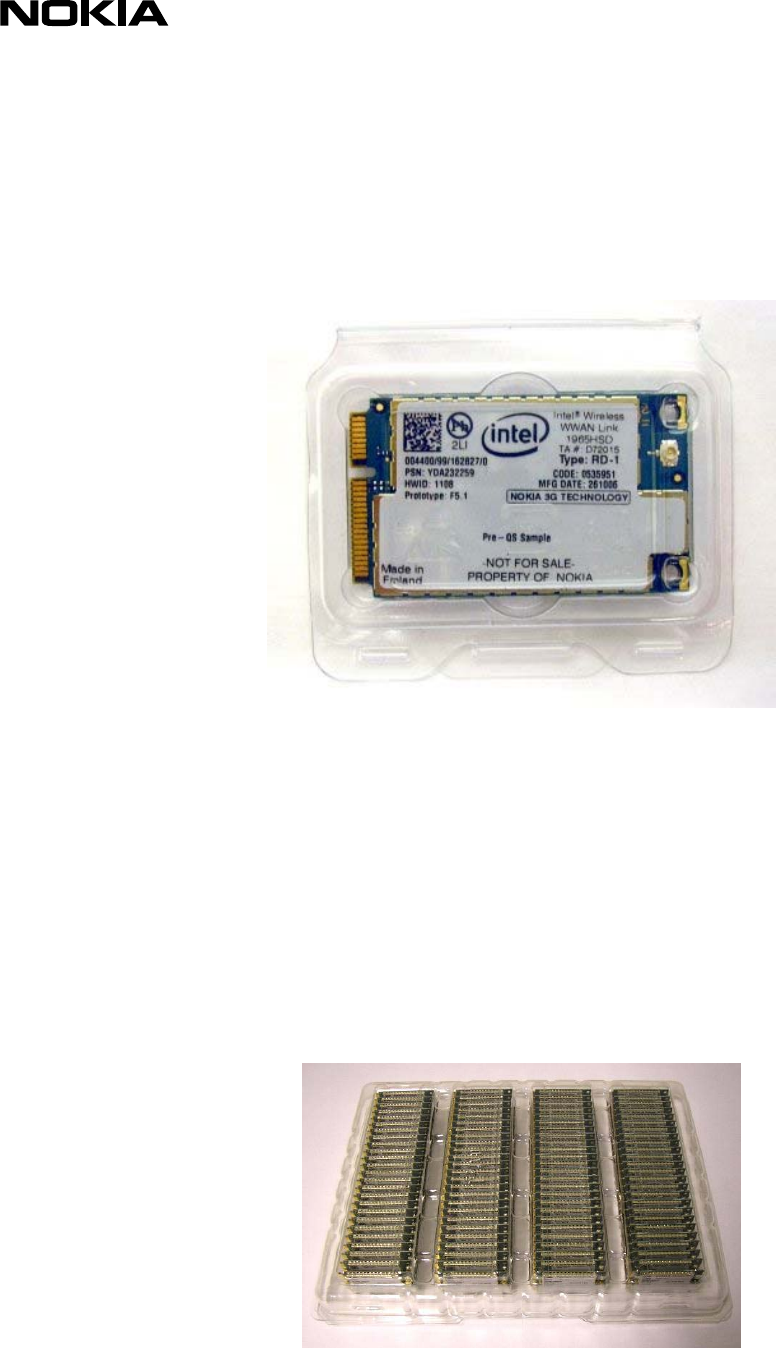
Wireless Platforms
CM/BU 4 (10)
RD-1/RD-2 handling guidelines for OEMs Print Date: 1/15/2007 Copyright © 2007 Nokia.
4 Unpacking
The modules are shipped in either single module clamshell or 100 module trays
4.1 Individual Module Clamshell
Figure 1: Representative* example of individual module Single clamshell with RD-1/RD-2 module
The module should only be removed from the clamshell package directly before insertion into the host laptop. The
packaging is opened by holding the middle tab in between the thumb and forefinger of one hand and gently prising
one of the outer tabs using the other thumb and forefinger. This process should be repeated for the other outer
tab. Once both of the outer tabs have been freed from the centre tab then the packing should be bent back along
the hinge line until flat. Holding one hand out flat the packaging can be place open side down on the palm of the
hand and gentle pressure applied to the back of the package until the module pops out into the palm, the
packaging should then be place to one side. The module should then be held prior to installation in accordance
with the General Handling guidance given in paragraph 5.1
4.2 100 Module Trays
Figure 2: Representative* example of 100 module clamshell with RD-1/RD-2 modules
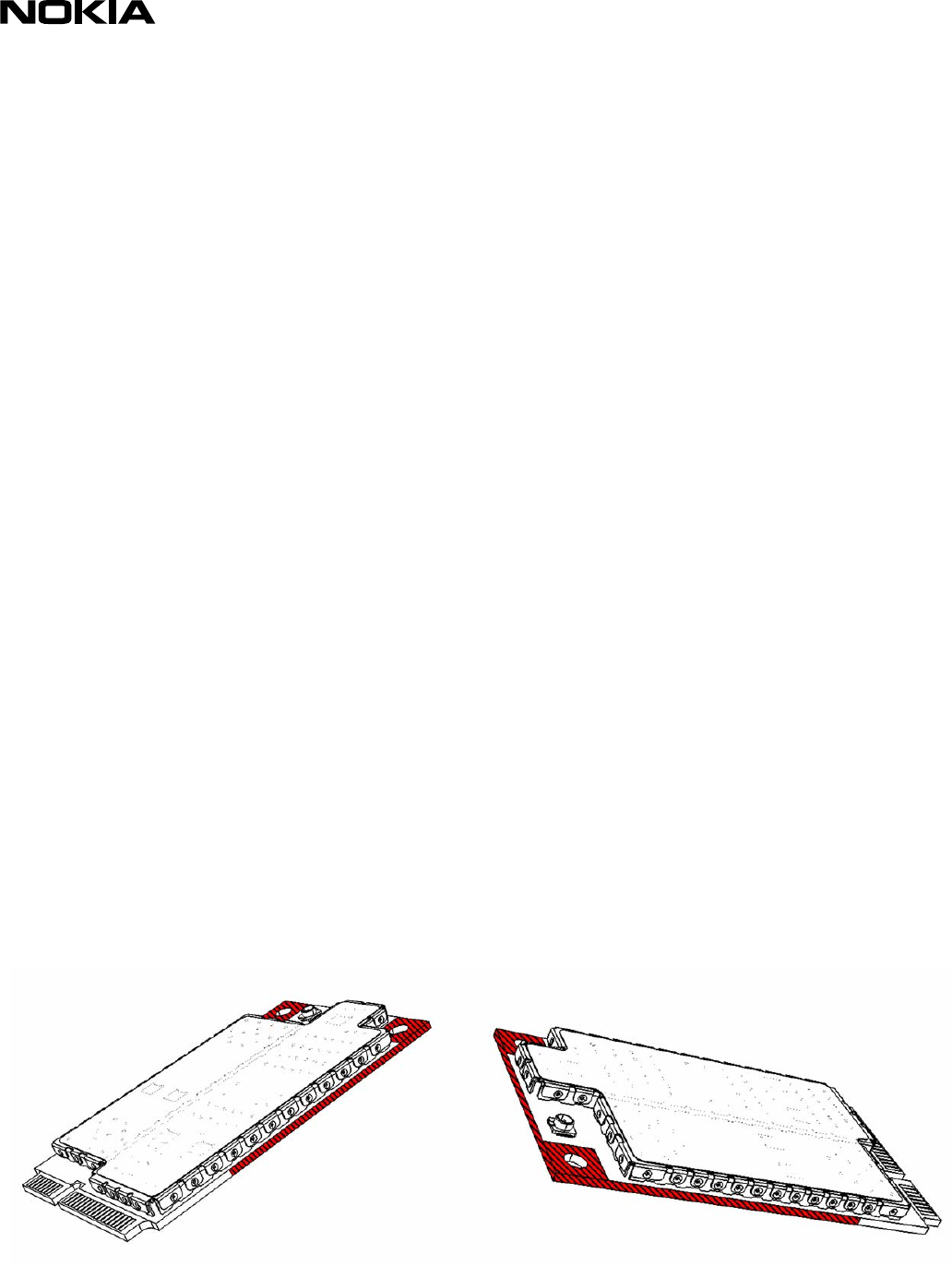
Wireless Platforms
CM/BU 5 (10)
RD-1/RD-2 handling guidelines for OEMs Print Date: 1/15/2007 Copyright © 2007 Nokia.
The module should only be removed from the clamshell package directly before insertion into the host laptop.
Before opening the packaging the correct orientation of the package top side must be checked and set from the
package markings. The packaging is opened by placing the thumb in bottom of package bevelled slot, located each
corners in package cover, and gently prising package cover and bottom off using the other thumb. This process
should be repeated for the opposite corner. Once two or more corners from the package coverage have been freed
from the package bottom the cover of the package can be removed. The package cover should be place to one
side. The module is removed from the package by gripping the corner with the PWB hole between the thumb and
forefinger and lifting module gently off from the package. The module should then be held prior to installation in
accordance with the General Handling guidance given in paragraph 4.2
*Figures 1 and 2 are intended to be representative of the packaging discussed and should not be considered as constituting a description of the
actual module(s) and/or packaging delivered.
5 Handling
5.1 General Handling
PCI Express Mini Card circuit boards are significantly thinner than standard PC motherboards. A consequence of
this is that solder joints on the PCI Express Mini Card circuit boards are more susceptible to cracking and damage
resulting from bowing and flexing of the circuit board material during handling. Accordingly the RD-1/RD-2 WWAN
module should be treated with significantly more care to avoid damage.
The module should not be intentionally bent along any axis. When inserting the module into the host PC pressure
should only be applied along the axes and at the points prescribed in this document.
The module should be lightly gripped between the thumb and forefinger of the same hand touching only the edge
areas shown below in red.
Figure 3: Safe module gripping areas highlighted in red and diagonal lines
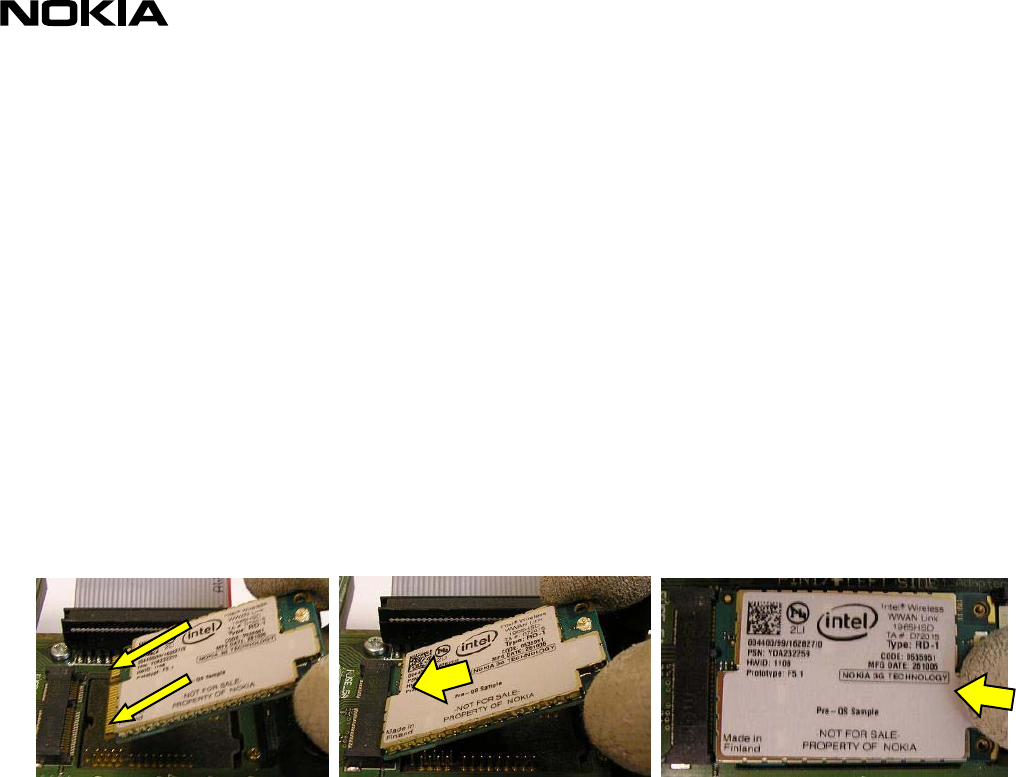
Wireless Platforms
CM/BU 6 (10)
RD-1/RD-2 handling guidelines for OEMs Print Date: 1/15/2007 Copyright © 2007 Nokia.
6 Installation
Prior to installation into the host laptop the laptop must be grounded and in a completely powered down state with
the battery and any external power supplies removed.
6.1 Insertion into PCI Express Mini Card Connector
The module shall be inserted according to the following steps:
1. Offer the module edge connector up and slide into the female PCI Express Mini Card receptacle such that
both corners of the module contact the respective corners of the receptacle concurrently.
NOTE: Different PCI Express Mini Card connectors may have prescribed insertion angles and these should
be checked prior to offering the module for insertion from the applicable manufacturer’s guidelines.
2. Gently slide the module into the receptacle under resistance is felt.
3. Press gently on the module at the point indicated below until the module is seated and a click is felt from
the retaining latches.
STEP: 1. 2. 3.
Figure 4: Card Insertion into PCI Express Mini Card Connector
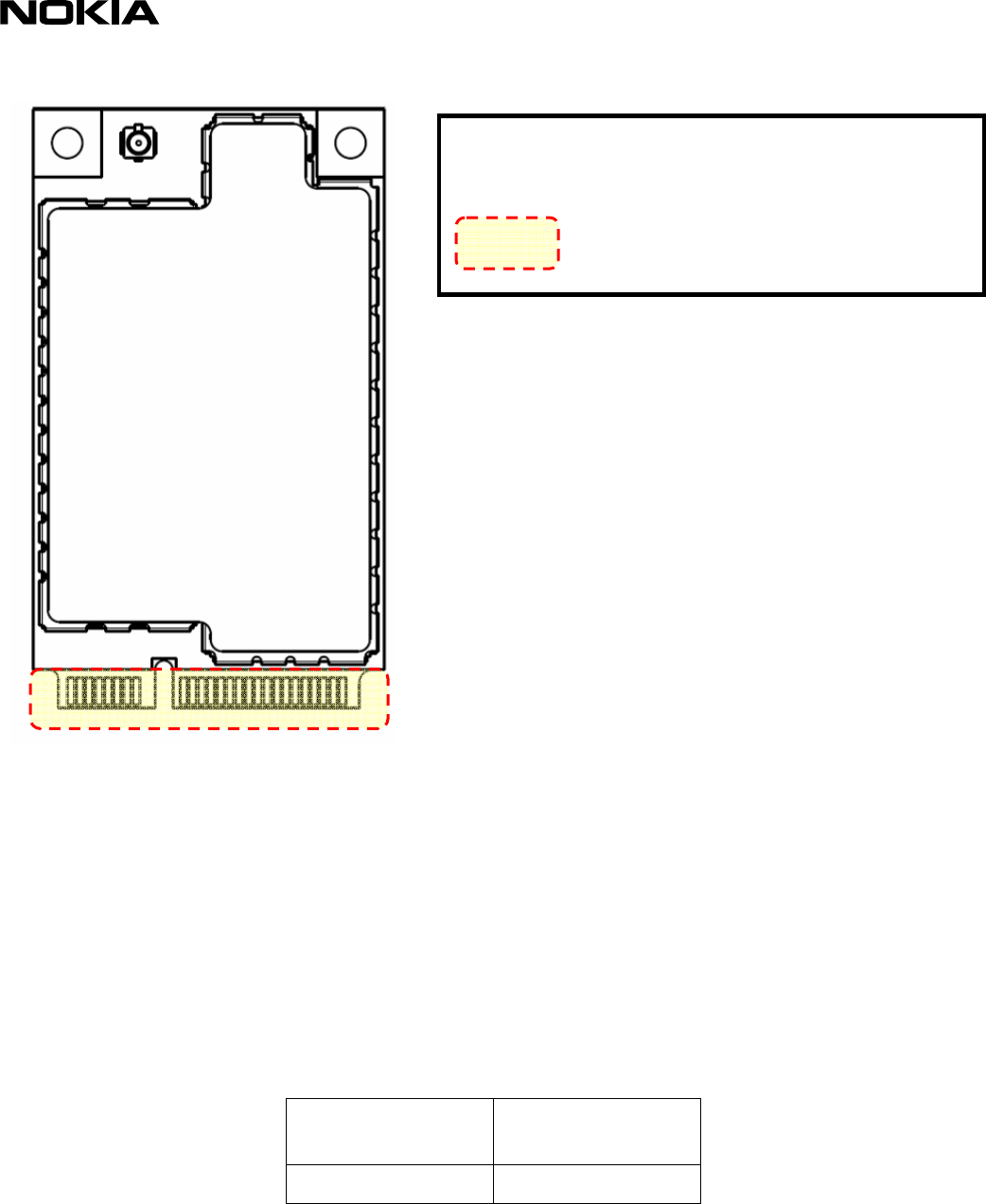
Wireless Platforms
CM/BU 7 (10)
RD-1/RD-2 handling guidelines for OEMs Print Date: 1/15/2007 Copyright © 2007 Nokia.
Figure 5: Safe Load and Support Points (Module Installation)
6.1.1 Maximum Safe Load (Module Insertion)
The maximum pressure applied to the point shown in Figure 5 and the resulting deformation shall not exceed that
shown in the table below:
Maximum Safe Load
(N)
Corresponding
Maximum Safe
Deflection (mm)
15 < 0.35
Table 1: Maximum Safe Load and Resulting Deformation (Module Insertion)
X X Safe Load Point
Fixed Support Area
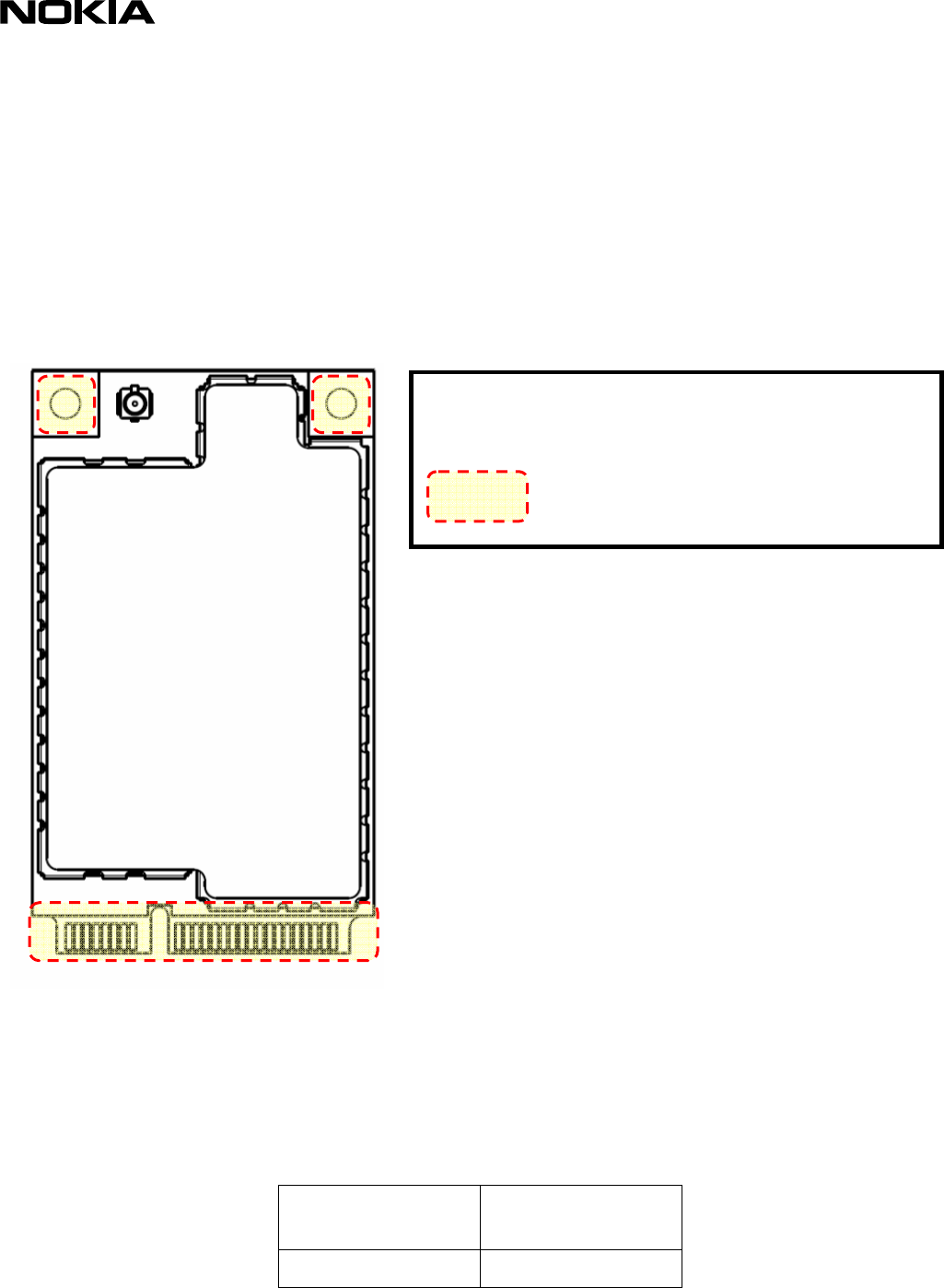
Wireless Platforms
CM/BU 8 (10)
RD-1/RD-2 handling guidelines for OEMs Print Date: 1/15/2007 Copyright © 2007 Nokia.
6.2 Antenna Connection
The antenna coaxial shall be connected only after the module has been seated in the host laptop and according to
the following steps below:
1. Offer the female plug up to the module socket ensuring that the barrels of both connecting parts are
parallel.
2. Press gently on the back plate of the female plug in the same plane as the barrels of both connecting parts.
3. Remove pressure as soon as the connection is made. The connection is made when a click is felt.
NOTE: Excessive twisting moments during connection may result in damage to the internal conductors.
NOTE: No strain should be placed upon the antenna coaxial or female plug.
Figure 6: Safe Load and Support Points (Antenna Connection)
6.2.1 Maximum Safe Load (Antenna Connection)
The maximum pressure applied to the point shown in Figure 6 and the resulting deformation shall not exceed that
shown in the table below:
Maximum Safe Load
(N)
Corresponding
Maximum Safe
Deflection (mm)
30 < 0.55
Table 2: Maximum Safe Load and Resulting Deformation (Antenna Connection)
X X Safe Load Point
Fixed Support Area
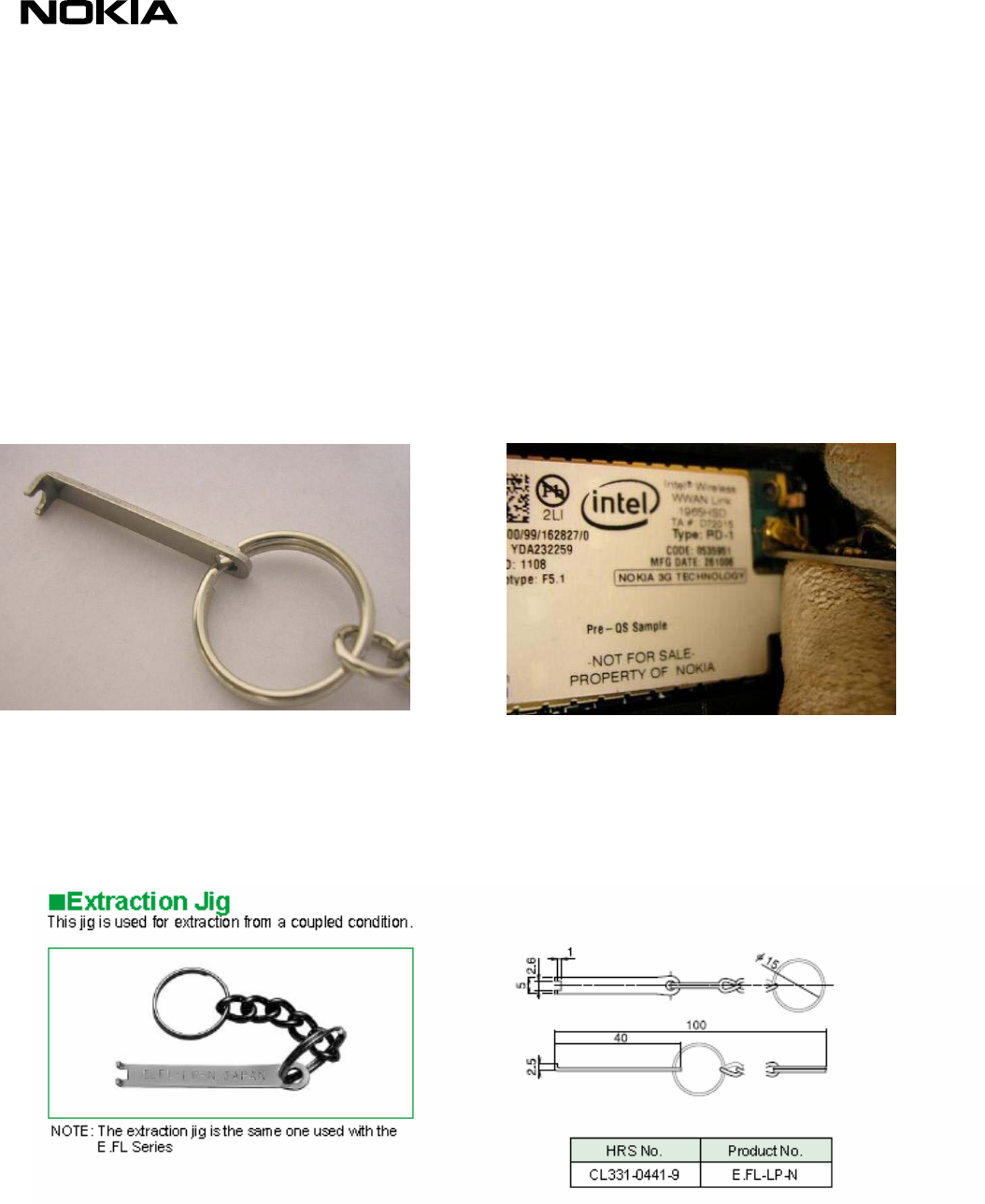
Wireless Platforms
CM/BU 9 (10)
RD-1/RD-2 handling guidelines for OEMs Print Date: 1/15/2007 Copyright © 2007 Nokia.
6.3 Antenna Disconnection
The antenna shall be disconnected according to the following steps:
1. Hook the u-shaped end of the Antenna Extraction Tool* under the female plug.
NOTE: The module shall remain seated in the host laptop prior to antenna disconnection
2. Gentle apply tension to the tool.
3. As soon as disconnection is noted relax the tension on the tool
4. Carefully withdraw the female plug ensuring that no load is place upon the coaxial cable.
* The Antenna Extraction Jig is a commercially available item see Figure 9
Figure 7: Antenna Extraction Jig Figure 8: Antenna Disconnection
Figure 9: Hirose Electric Company Ltd Extraction Jig
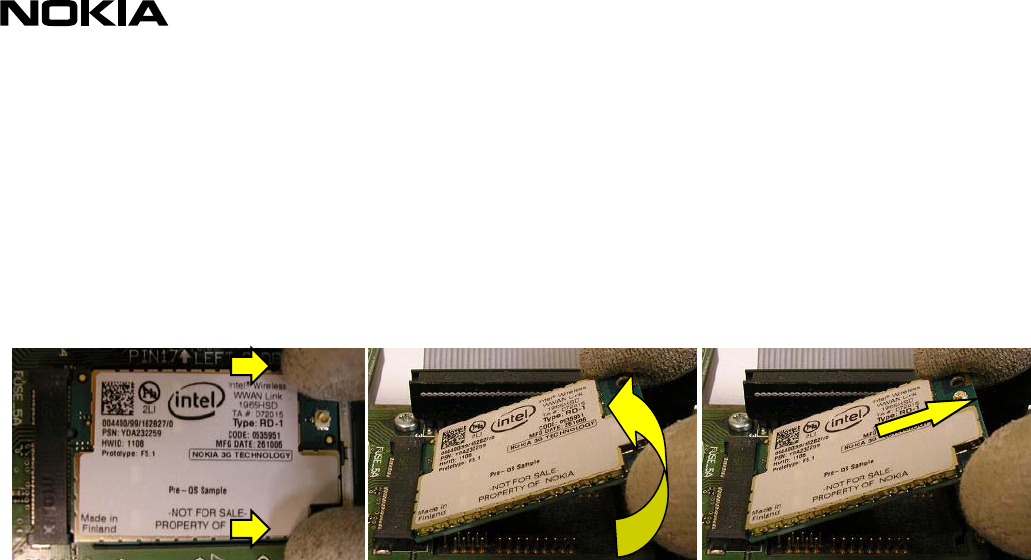
Wireless Platforms
CM/BU 10 (10)
RD-1/RD-2 handling guidelines for OEMs Print Date: 1/15/2007 Copyright © 2007 Nokia.
6.4 Removal from PCI Express Mini Card Connector
The module shall be removed according to the following steps:
1. Press gently on the retaining latches until the module is unseated and free to rise.
2. Module edge rises up automatically by the mechanical property of PCI Express Mini Card Connector.
3. Gently slide the module from receptacle at the point indicated in Figure 3
STEP: 1. 2. 3.
Figure 10: Card Removal from PCI Express Mini Card Connector